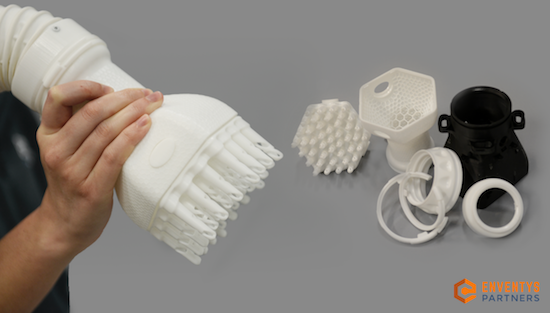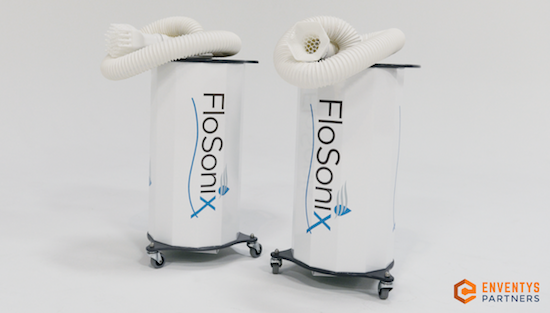3D Printing Deployed in the War on Head Lice
Enventys Partners, Stratasys leverage additive manufacturing to reduce costs, design constraints and lead time on new head lice treatment.

3D printing helped accelerate development and reduce the cost of producing the FloSonix lice treatment device. Image courtesy of FloSonix.
Latest News
February 26, 2021
If you ever want to see otherwise calm, even-tempered adults descend into unhinged terror and panic, just watch the reaction when an average parent gets a note or call from the school about head lice.
These itchy parasites have been with us since mammals emerged on the Earth, and head lice as a distinct species may seems to have appeared around 100,000 years ago. The CDC estimates there are about 6 to 12 million infections each year among children 3-11 years of age, and as many as 74 million infestiations for kids under the age of 18, and a cottage industry has emerged to help get rid of them. FloSonix Ventures recently tapped Enventys Partners to help design and manufacture a new gadget for the lice wars, and 3D printing played a key role.
Over time, lice have built up an immunity to the common chemical and pesticide treatments used in the past to kill them. In response, a burgeoning industry has sprung up employing a wide variety of techniques. Because chemical treatments do not work reliably, the only way to really get rid of lice is to get physical: you have to kill the adults and manually remove all of the eggs (a tedious exercise in literal nit-picking). But killing lice is not easy. You can suffocate them with heavy oils (a cheap, but messy, method is to coat the scalp with olive oil). They can also be killed using heat, which is handy for hats and bed clothes, not so much for your third grader's head. According to Mordor Intelligence, the lice treatment market is growing at a healthy CAGR of 6.6% through 2026.
Enter FloSonix, which has created a sort-of mobile heat pump to kill lice eggs right on the scalp. The company approached Enventys because they needed to design and manufacture a new device with better ergonomics for end users. With a projected demand for 200-300 devices annually, and each device requiring many plastic components, the costs associated with traditional tooling, injection molding, and manufacturing were too high to make the device cost-effective. Enventys recommended additive manufacturing to better balance cost and quality.

Because of the mechanical, aesthetic, and heat resistance properties required for the medical Enventys selected the Stratasys Origin One 3D printer.
“The Origin One 3D printer allowed us to make several initial options for our client to choose from and then make tiny tweaks almost in real-time without delaying the project or incurring huge expenses,” said TJ Root, senior design engineer for Enventys Partners. “By prototyping on the same machine that will make the final parts, we had extreme confidence in every piece we were making.”
Origin leveraged the materials portfolio of Henkel Loctite 3DP resins to meet the device requirements. Loctite 3D 3843, IND403 and MED413 matched FloSonix's requirements for toughness, temperature and color needs in a single device, providing high part dimensional stability and an exceptional surface finish. The final material is also sterilizable, allowing FloSonix to provide reusable tips for its customers instead of one-time-use consumables.
Texture designed in nTop software to improve device ergonomics while reducing material volume.
“We are excited to see this product come to market,” said Ken Kisner, Henkel's Head of Innovation for 3D printing. “This application highlights the versatility of 3DP and the multitude of applications that Loctite 3DP materials can serve.”

Using additive manufacturing also enabled more design freedom, including component consolidation, adding assembly features, and final tuning parameters to achieve better accuracy, the company says. According to Enventys, using a traditional method like injection molding would have increased the number of parts required, the assembly steps and the overall device cost. Additive also reduced the number of part suppliers for prototyping and final production. It also enabled the team to freeze some components' design and start their manufacture while still adjusting the final product.
“Enventys Partners' approach to this application is incredibly innovative and an ideal process for any brand taking a complex mid-volume product to market quickly and economically,” said Christopher Prucha, co-founder of Origin and now the head of the Origin team at Stratasys. “By using an additive first approach; combining parts, designing custom textures, and taking advantage of Origin One's material selection and final part quality, they've created a playbook for product development using additive manufacturing.”
Sources: Press materials received from the company and additional information gleaned from the company’s website.
More Stratasys Coverage
Subscribe to our FREE magazine, FREE email newsletters or both!
Latest News






